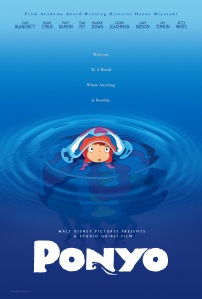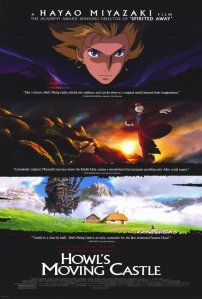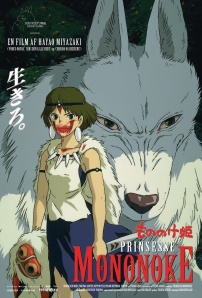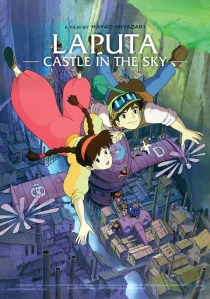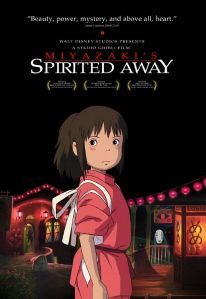 Spirited Away is one of my personal favorites, but I wanted to hold off on writing about it until now. It was the first film from Studio Ghibli that I had seen; this was back in 2002, shortly after it was released in the United States. I was ten years old at the time, and to be honest, everything about this film terrified me and put me off of Studio Ghibli films for a good while. It wasn’t until I was thirteen that I decided to give it another watch, and I’m very glad I did; I’ve been enraptured by Studio Ghibli films ever since.
Spirited Away is one of my personal favorites, but I wanted to hold off on writing about it until now. It was the first film from Studio Ghibli that I had seen; this was back in 2002, shortly after it was released in the United States. I was ten years old at the time, and to be honest, everything about this film terrified me and put me off of Studio Ghibli films for a good while. It wasn’t until I was thirteen that I decided to give it another watch, and I’m very glad I did; I’ve been enraptured by Studio Ghibli films ever since.
Synopsis
Spirited Away is a 2001 fantasy film directed by Hayao Miyazaki. It is, arguably, Studio Ghibli’s most well-known film, and it’s no surprise- it is notable for being the first anime film to win an Academy Award. The story is set in modern-day Japan, with a young girl named Chihiro and her parents in the process of moving to a new town. However, during the course of their drive, Chihiro’s father decides to take a detour and the family winds up in a strange world of spirits.
The resulting tale is very much like Alice in Wonderland, but with a Studio Ghibli twist.
Analysis
Spirited Away is stuffed to the brim with all kinds of themes such as growing up, rebirth, present and past, identity, greed, love, and of course, the environment.
The most prevalent themes in the film, however, would probably be the themes of growing up and identity. Spirited Away focuses on the coming-of-age of the main character, Chihiro, and her transition from a young, whiny, selfish girl to a hardworking young woman. The film opens with Chihiro being upset over the move to a new town. She is portrayed as whiny and petulant; she only has complaints about the move, and when her parents take a detour and come across what appears to be an abandoned theme park, she clings to her mother and gives her parents a difficult time.
Many people have drawn comparisons between Spirited Away and Lewis Carroll’s classic tale, Alice’s Adventures in Wonderland, and it’s really no surprise. Both girls are young and pre-pubescent, and they both end up in a strange world. In Ando Satoshi’s article Regaining Continuity with the Past: Spirited Away and Alice’s Adventures in Wonderland, he compares Alice and Chihiro, stating that they’re both at the point in their lives where they’re about to go through puberty and come into their maturity, and they’re both going through an identity crisis. He also makes the statement that girls’ transitional periods are recurring themes in Miyazaki films. Another film by Hayao Miyazaki that immediately comes to mind is Kiki’s Delivery Service- a film that follows the story of a thirteen year old witch-in-training named Kiki and her journey to come into her maturity, come to terms with who she is, and effectively come into her full powers as a witch.
However, Spirited Away takes the loss of identity a step further. Not only is Chihiro frustrated and unsure of herself at the beginning of the film (she is being uprooted from her old hometown and is moving to a new place; on top of that, Chihiro is on the cusp of adolescence), she literally loses her name when she enters the world of spirits.
The majority of Spirited Away takes place in a bathhouse for spirits that is run by a witch named Yubaba. Yubaba is corrupt and greedy, and she controls her employees by signing a contract with them; part of the contract is to sign away your name. In Chihiro’s case, when she signs a contract to work at the bathhouse, she becomes ‘Sen’. This is Chihiro’s symbolic “death”; her life as a whiny, petulant, sheltered girl is over, and she must now become this new person who is hardworking and strong (her symbolic “rebirth”). Her new identity is that of ‘Sen’, and she no longer shies away from responsibility and hard work, something that stays with her throughout the rest of the film.
The film also contains the themes of greed and corruption. In the beginning of the film, Chihiro’s family comes across what they assume is an abandoned theme park (when in reality, it’s the entrance to the world of the spirits). Chihiro’s parents are immediately drawn to the spirit food; they don’t give much thought to how they’ll be paying for the food (Chihiro’s dad makes the off-handed comment, “I have credit cards and cash”, meaning everything will be okay as long as he has money) and start gorging themselves on it. They transform into pigs, which highlights not only their gluttony, but also their greed.
Yubaba, who runs the bathhouse in the spirit world, is also greedy; she makes comments throughout the film about money and gold, and how much Sen’s transgressions are costing her. The bathhouse atmosphere itself is very corrupt, and this becomes obvious when a spirit called No-Face goes crazy (he feeds off of the greed that pervades the bathhouse. Sen makes the comment that “being in the bathhouse makes [No-Face] crazy”); he tempts the employees in the bathhouse with gold, and everyone in the bathhouse is eager to please him and be at his beck and call because of this wealth.
Spirited Away is laced with environmental themes, much like a few of Hayao Miyazaki’s other films. In the film, a grotesque, smelly spirit that is in need of replenishing visits the bathhouse. The inhabitants of the bathhouse eventually find out that this spirit is actually a powerful river spirit that was nearly overcome by the pollution and desecration of its river (in a scene from the film, the bathhouse spirits are busy removing the debris and waste that coats the river spirit. Among some of the waste removed is fishing wire, tires, household items that were thrown away, and even a bicycle).
The plight of Haku is also an example of the presence of the environmental themes in the film. It is eventually revealed that Haku is actually the spirit of the Kohaku River, a river that has long since been destroyed in the name of human settlement (Chihiro remarks that the Kohaku River is “all apartments now”). Because of this, Haku lost his home and his identity and, with no place to go, came to the bathhouse, where he became Yubaba’s apprentice. It wasn’t until Chihiro returned his name to him did Haku remember his true identity.
Conclusion
Spirited Away can be interpreted in many ways, and there are a large number of themes that are present in the film. This analysis has barely scratched the surface. However, the themes that are most obvious are growing up, identity, greed and corruption, and the environment. Like with Kiki’s Delivery Service, Spirited Away resonates with audiences because the character of Chihiro is relatable; In a 2001 interview, Miyazaki stated that he aimed to create a film that spoke to girls Chihiro’s age). There are many messages that audiences can take away from the film, as it is rich in detail, storytelling, and depth.
References
Satoshi, A. (2008). Regaining Continuity with the Past: Spirited Away and Alice’s Adventures in Wonderland. Bookbird: A Journal of International Children’s Literature 46(1), 23-29. The Johns Hopkins University Press. Retrieved April 25, 2014, from Project MUSE database. http://muse.jhu.edu/journals/bookbird/v046/46.1.satoshi.html
Miyazaki, H. (Interviewee). (2002). Hayao Miyazaki [Interview Transcript]. Retrieved from Midnight Eye Web Site: http://www.midnighteye.com/interviews/hayao-miyazaki/
Miyazaki, H. (Director). (2001). Spirited Away [Motion Picture]. Japan: Studio Ghibli

